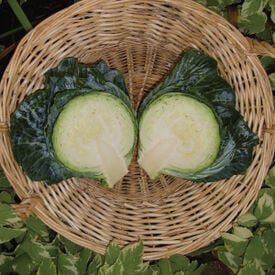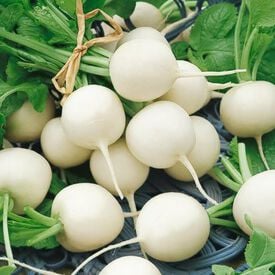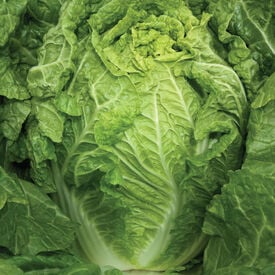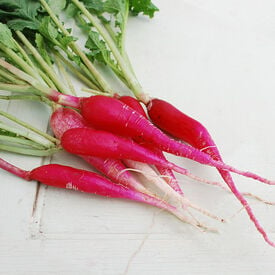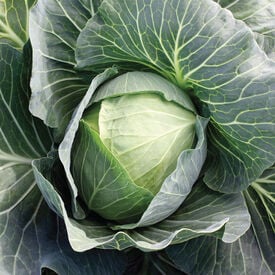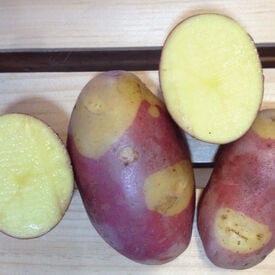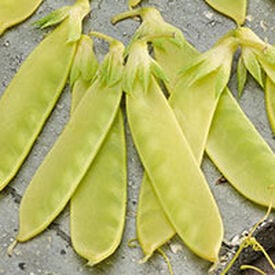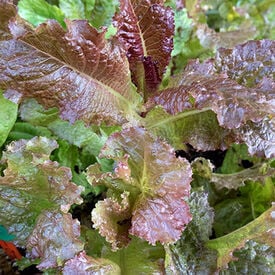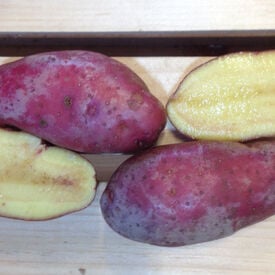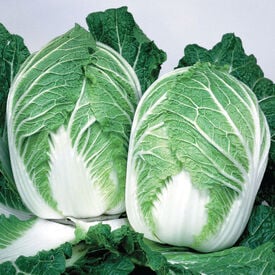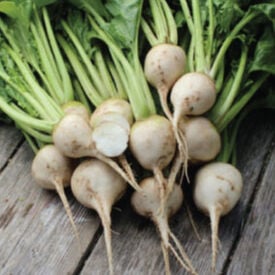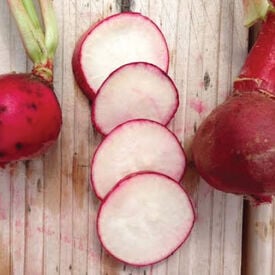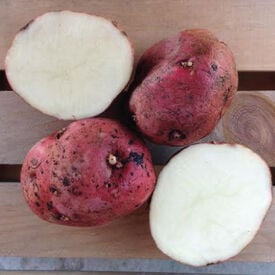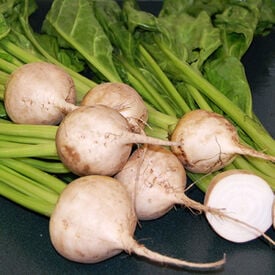Red Arrow radish seeds produce fast-growing plants that are primarily cultivated for their vibrant red stems and lush green leaves rather than their roots. This variety is especially prized for microgreens and edible shoots, offering a crisp texture and a bold, spicy radish flavor that adds zest to salads, sandwiches, and garnishes. Red Arrow is easy to grow, thrives in full sun to partial shade, and is well-suited for both garden beds and indoor trays. Its striking color and strong flavor make it a favorite among chefs and home growers alike.
Dwarf White Sugar peas are a compact, heirloom variety of edible-podded peas prized for their sweet, tender pods and early harvest. Growing to just about 2 to 3 feet tall, they require little to no support, making them ideal for small gardens and containers. These peas produce delicate white flowers followed by flat, crisp pods that can be eaten whole, either raw or cooked. Known for their mild, sugary flavor, Dwarf White Sugar peas are often harvested young for the best texture and taste. They thrive in cool weather and are typically among the first vegetables ready to harvest in the spring garden.
First released in 1909 by H. Hartmann & Company, this historic Danish cabbage has earned its reputation as a dependable garden classic and a benchmark for many modern varieties. It forms dense, well-wrapped heads measuring about 6–8" across and weighing 3–4 pounds, making it an excellent choice for smaller gardens. Plants mature quickly, adapt well to a wide range of growing conditions, and show strong resistance to splitting. Once harvested, the firm heads store exceptionally well—often lasting up to six months—adding to the long-standing appeal of this time-tested heirloom.
Atomic Red carrots are rich in vitamins and minerals! Bright red root, tapered 1.5 x 11" long, super healthy high lycopene, crispy, intense color even when cooked. Atomic Red carrots are very healthy and unique-looking. The bright red is sure to add color to your garden. Atomic Red is especially high in the anti-oxidant lycopene, which is also found in tomatoes.
Sugar Lace peas are a unique variety of edible-podded peas known for their attractive, semi-leafless vines with tendrils that help them cling and climb, reducing the need for support. These peas produce sweet, crisp pods that are stringless and ideal for fresh eating, stir-frying, or steaming. Unlike traditional shelling peas, Sugar Lace peas are enjoyed whole, pod and all, making them a convenient and nutritious garden snack. They are a late-season type with high yields and excellent disease resistance, thriving best in cool weather and well-drained soil. Their compact growth habit also makes them suitable for small gardens or container planting.
Dating back to the 1800s, Hailstone is a classic heirloom radish prized for its exceptionally fast maturity. This variety produces small, round, snow-white roots that resemble tiny hailstones, with compact tops and slender taproots that make it ideal for close spacing. The crisp 1–1½ inch globes offer a bright, tangy flavor with a pleasant pungency, and the firm white flesh stays fresh and appealing longer than many other radishes. Hailstone performs best when planted very early in spring in a sunny, well-prepared bed enriched with organic matter. For a steady supply, sow seeds every two weeks and harvest before hot summer weather, which can affect flavor and texture.
China Gold (F1) cabbage has exceptional color both inside and out. It has a compact frame, good weight and is very slow bolting.
The Cincinnati Market Radish is a uniquely skinny and elongated pink to red radish that is a fresh-from-the-garden-favorite! This six inch variety has a delicately mild taste with a very tender and crisp texture, making it perfect for fresh eating. The early maturing radish has been an heirloom garden favorite since 1885. You can enjoy the delicious Cincinnati Market from spring to fall.
SuperStar is a hybrid cabbage that produces the highest quality fresh market cabbages. It has excellent wrappers for a fancy pack along with excellent holding ability in the field and after harvest.
SPRING SHIPPING - Certified - The Pinto Gold is a unique two colored potato! This potato variety has a purple skin with its gold flesh showing a bit on the outside. The Zebra or Pinto Gold is a beautiful gourmet style potato. This unique potato looks great when baked and served whole. The Pinto Gold has a great flavor with a high starchiness. The Pinto Gold is a favorite for fresh markets!
The Golden Sweet Pea is really the gold standard for yellow shelling peas! This yellow pod snow pea grows to be around 3 inches long. This pea has a wonderful sweet taste and can be eaten raw in salads or steamed as a side dish. The large 5-6 foot vines need to be trellised and will grow beautiful purple flowers. Certified Organic. Learn more about our organic seeds.
The Red Velvet Lettuce produces very dark maroon to greenish-bronze tinged colored leaves that have a nice chewy texture. This beautifully unique variety is a great choice for mixed salad greens. This lettuce is slow to bolt and will become bitter in the heat.
SPRING SHIPPING - Certified - The French Fingerling is a gourmet quality fingerling with a deliciously beautiful bright red skin. This fingerling has red skin and a creamy yellow flesh. The French Fingerling produces good quality, medium size tubers which are beautiful when served in various dishes.
China Express is a chinese cabbage that is a widely-adapted and can be grown throughout. This is a very uniform cabbage with tightly wrapped heads. Medium-sized that are fast maturing.
The White Albino beet plants produce good yields of very sweet white beets. The beets are white and will never stain again! This gourmet beet is ideal for boiling, pickling, baking, and freezing.
The Champion Radish is slow to become pithy. This radish is an excellent cooler weather variety, especially for short season climates. This bright red, crisp, round radish has large tops and is a good choice for early or late plantings. This highly recommended radish is great for eating fresh, in salads or for garnishes.
SPRING SHIPPING - Certified - The La Soda is a great potato boiled, baked or fried! This tasty potato variety has a distinctive rosy skin and waxy white flesh. La Soda is a widely adapted and reliable potato that withstands cold, heat and drought.
The Avalanche beet, scientifically known as Beta vulgaris var. conditiva 'Avalanche,' is a popular variety of beetroot that has gained recognition for its exceptional characteristics. Historically, beets have been cultivated for thousands of years, with evidence of their consumption dating back to ancient civilizations like the Egyptians and Greeks. The Avalanche beet is a modern cultivar that has been selectively bred for its unique attributes. Avalanche beets are renowned for their mild, sweet flavor and tender texture. They are typically harvested at a smaller size, around 2-3 inches in diameter, making them ideal for salads, roasting, and pickling. The days to maturity for Avalanche beets range from 45 to 50 days, making them a relatively quick-growing crop. These beets are characterized by their crisp, pure white flesh and skin, giving them their distinctive appearance. They are also known for their resistance to common beet diseases such as Cercospora leaf spot and Rhizoctonia root rot, which can help ensure a healthy yield. When growing Avalanche beets, it's essential to provide them with well-draining, loose soil that is rich in organic matter. They thrive in full sun but can tolerate partial shade. Proper spacing is crucial, with rows spaced about 12-18 inches apart and individual beets planted 2-4 inches apart within the rows. Adequate watering is necessary to keep the soil consistently moist, but not waterlogged. With the right care and growing conditions, Avalanche beets can yield an abundant harvest of these delightful, mild-flavored, and visually striking vegetables.


